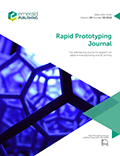|
Autores/as
Sedighi, Iman; Ayatollahi, Majid R.; Bahrami, Bahador; Pérez-Martínez, Marco A. ; Garcia-Granada, Andres A. ; Garcia-Granada, Andres A.
|
Abstract
Purpose: The purpose of this paper is to investigate the effect of layer orientation on the tensile, flexural and fracture behavior of additively manufactured (AM) polycarbonate (PC) produced using fused deposition modeling (FDM). Design/methodology/approach: An experimental approach is undertaken and a total number of 48 tests are conducted. Two types of tensile specimens are used and their mechanical behavior and fracture surfaces are studied. Also, circular parts with different layer orientations are printed and two semi-circular bending (SCB) samples are extracted from each part. Finally, the results of samples with different build directions are compared to one another to better understand the mechanical behavior of additively manufactured PC. Findings: The results demonstrate anisotropy in the tensile, flexural and fracture behavior of the additively manufactured PC parts with the latter being less anisotropic compared to the first two. It is also demonstrated that the anisotropy of the elastic modulus is small and can be neglected. Tensile strength ranges from 40 MPa to 53 MPa. At the end, mode I fracture toughness prediction curves are provided for different directions of the FDM samples. Fracture toughness ranges from 1.93 to 2.37 MPa.mm1/2. Originality/value: The SCB specimen, a very suitable geometry for characterizing anisotropic materials, was used to characterize FDM parts for the first time. Also, the fracture properties of the AM PC have not been studied by the researchers in the past. Therefore, fracture toughness prediction curves are presented for this anisotropic material. These curves can be very suitable for designing parts that are going to be produced by 3D printing. Moreover, the effect of the area to perimeter ratio on the tensile properties of the printed parts is investigated.
|

WoS
Scopus
Altmetrics
 
|
